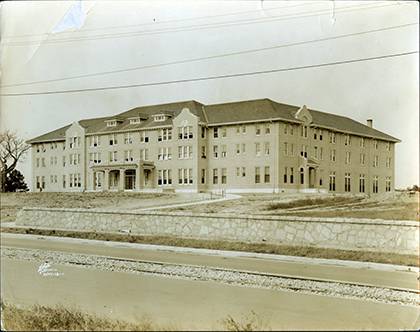Dorm’s History Tied to Local Black Residents
In 1920, Durham's black leaders lobbied to name a Duke building

Black students, faculty and staff have always played an important part in Duke's history, but as Duke marks Black History Month, it's worth noting the local Durham community has a hand in shaping the university, too.
In early 1920, when Duke was still known as Trinity College, local Durham residents took it upon themselves to build and secure a special name for a soon-to-be dormitory for women on what is now East Campus.
The building, Southgate Residence Hall, was named for James Haywood Southgate, chairman of the board of trustees for Trinity from 1896 until his death in 1916 and a prominent local businessman.
In Durham, Southgate earned a reputation as an important citizen who believed in fairness on issues of education, religion and culture. Through his commitments to the YMCA, Methodist Church, Durham Conservatory of Music and Trinity College, Southgate befriended many in Durham, including black residents.
Among those leading the charge to have the new building named after their friend were the Royal Knights of King David, an organization formed in the late 19th century by John Merrick. Merrick, a Clinton, NC native, was born into slavery and became a Durham businessman and owner of a chain of barbershops.

On March 20, 1920, a group of prominent black residents gathered at the Royal Knights offices on Parrish Street to raise money in an effort to secure Southgate's name for the new building, which would cost $211,000 to build.
Among those donating included businessmen Charles Clinton Spaulding and J.M. Avery, as well as teacher William Gaston Pearson, a former slave who became known for his commitment to education in Durham County. Both Spaulding and Pearson have Durham elementary schools bearing their name today.
At the March 20 meeting, black residents donated $285, which is equivalent to about $3,300 today. The recorded minutes show that all those in attendance believed Southgate was a pivotal member of the Durham community during his life.
"Many of the men present spoke of the intimate contact [sic] it had been their great pleasure to share with the deceased, and of the many deeds of kindness by which his life was beneficial to the community and to them personally; especially of his staunch support of right and justice, at all times and under all circumstances," wrote Royal Knights' secretary Robert McCants.
In addition to local residents, students and employees at Trinity College also gave $8,500 for the building - almost $100,000 by today’s standards.
Southgate Residence Hall opened in 1921 and provided the largest dormitory then available for the women who attended Trinity. The building was hailed as a marvel for a college campus and included 66 rooms, a gym, assembly hall, dining room and infirmary, along with classrooms.
Today, Southgate is home to about 150 first-year students and still offers an array of amenities, including a common kitchen, common room with television and piano, a game room, gymnasium with basketball court, laundry facilities and a study room.
